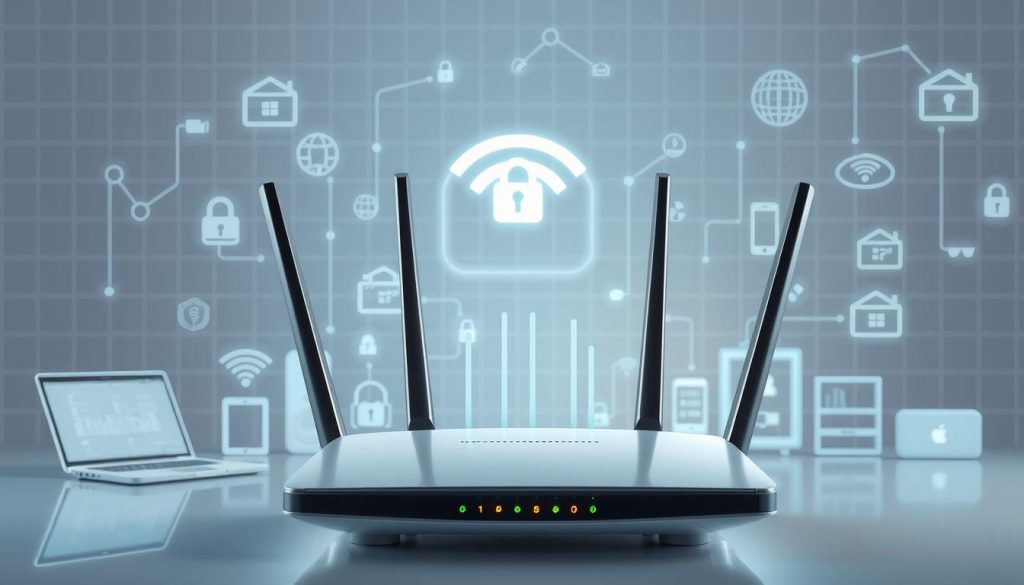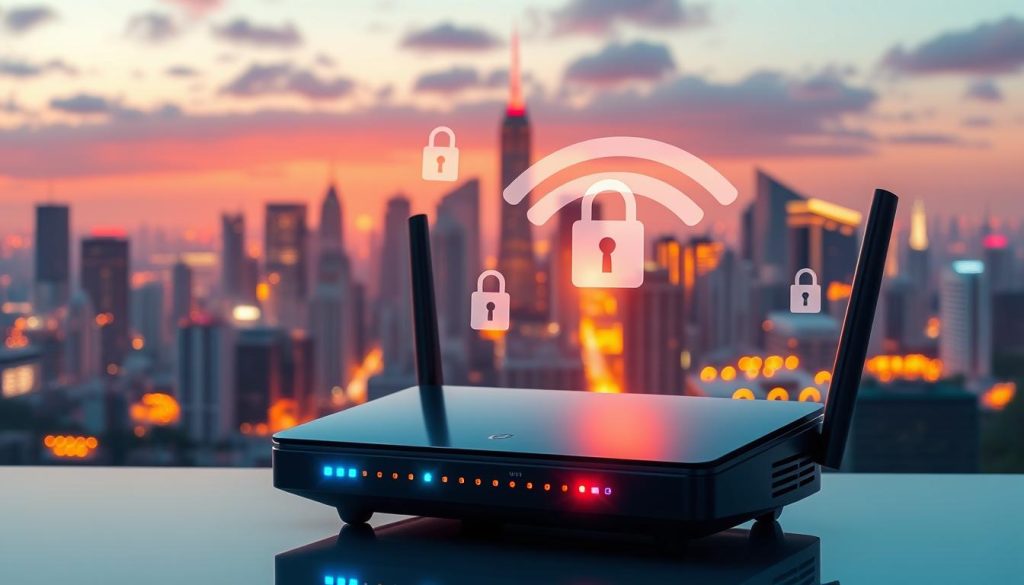As we move forward in wireless technology, it’s key to know about Wi-Fi6 & Wi-Fi7. These new standards offer faster speeds and better security. They are a big step up from what we had before.
The newest Wi-Fi advancements come with improved security protocols. These are made to keep your network safe from new threats. With Wi-Fi7 coming, we can look forward to even stronger security for all our connected devices.
This article will explore the new security features of Wi-Fi6 & Wi-Fi7. We’ll see how these technologies can make your network safer and faster.
Key Takeaways
- Wi-Fi6 and Wi-Fi7 offer enhanced security protocols for better network protection.
- The latest Wi-Fi standards provide improved performance and lower latency.
- Understanding these advancements is crucial for securing your network.
- Wi-Fi7 promises even more robust security features for the future.
- Staying informed about Wi-Fi advancements is key to maintaining network security.
Introduction to Wi-Fi6 and Wi-Fi7
Wireless technology keeps getting better. Knowing about Wi-Fi6 and Wi-Fi7 is key. They bring faster speeds, lower delays, and better connections.
What is Wi-Fi6?
Wi-Fi6, or 802.11ax, is the sixth Wi-Fi generation. It’s made for places with lots of devices, like stadiums and malls. It uses new tech like OFDMA and MU-MIMO. Wi-Fi6 is way faster and can handle more devices than before.
What is Wi-Fi7?
Wi-Fi7, or 802.11be, is the newest Wi-Fi standard. It builds on Wi-Fi6 and promises even more. It has new features like 4096-QAM and MLO for better data transfer and less congestion. Wi-Fi7 is made for new tech like augmented reality and high-definition video.
Key Differences between Wi-Fi6 and Wi-Fi7
Wi-Fi6 and Wi-Fi7 differ in how well they perform. Wi-Fi7 has:
- Faster data transfer rates
- Lower latency
- Improved capacity
- Enhanced security features
Wi-Fi7 works with Wi-Fi6 devices, but for the best experience, you need Wi-Fi7 devices. Knowing these differences helps you pick the right tech for you.
The Importance of Security in Modern Wi-Fi Networks
As our digital world grows, keeping Wi-Fi networks safe is more important than ever. With more devices connected, Wi-Fi is a big target for hackers.
Increasing Cyber Threats
Cyber threats are getting smarter and more dangerous. Malware, ransomware, and unauthorized access are just a few risks Wi-Fi networks face. It’s key to know these threats and how to fight them.
- Malware and ransomware attacks that can compromise network integrity
- Unauthorized access to sensitive data
- Denial of Service (DoS) and Distributed Denial of Service (DDoS) attacks
The Role of Encryption
Encryption is crucial for keeping Wi-Fi networks safe. It makes data unreadable if it’s caught by hackers. Wi-Fi encryption protocols like WPA2 and WPA3 offer strong security.
WPA3, the latest encryption, brings even more security. It includes:
- Improved data protection
- Enhanced authentication mechanisms
- Better protection against brute-force attacks
Importance of Strong Authentication
Strong authentication is key to stopping unauthorized Wi-Fi access. It makes sure only approved devices and users can get in.

- Multi-factor authentication (MFA)
- Strong password policies
- Regularly updating and patching network devices
Key Security Enhancements in Wi-Fi6
Wi-Fi6 is a big step up in wireless security, with new features to fight off threats. It’s the latest Wi-Fi tech, aiming for a safer and more reliable connection.
WPA3: The Latest Security Protocol
WPA3 is a major upgrade in Wi-Fi6, bringing better encryption and ways to check who’s on your network. This means hackers have a harder time getting into your network. With WPA3, your data stays safe from threats.

Enhanced Open Networks
Wi-Fi6 also has enhanced open networks for public Wi-Fi. This adds security to open networks. Your data stays safe, even on public networks, thanks to encryption.
Improved Device Authentication
Improved device authentication is another big plus in Wi-Fi6. It makes it harder for bad devices to get into your network. This means your network is safer, giving you peace of mind.
In short, Wi-Fi6 brings many security upgrades. With WPA3, enhanced open networks, and better device checks, it’s a safer choice for wireless connections. It fights off new threats with a strong security system.
Security Innovations in Wi-Fi7
Wi-Fi7 is all about security, with new features to keep your network safe. It tackles cyber threats head-on, offering a secure and reliable connection.
Advanced Security Features
Wi-Fi7 improves on Wi-Fi6’s security, adding new features. It uses stronger encryption to keep data safe.
Enhanced Encryption Support: Wi-Fi7 uses the latest encryption standards. This makes your data safer from interception and eavesdropping.

Support for Enhanced Encryption
Wi-Fi7’s encryption is a big step up in cybersecurity. It uses advanced algorithms to protect your network from threats. This is crucial in today’s digital world, where keeping data safe is key.
- Improved data protection through advanced encryption
- Better security against cyber threats
- Enhanced confidentiality for sensitive information
Enhanced Authentication Mechanisms
Wi-Fi7 also has stronger ways to check who can join your network. This makes it harder for unauthorized devices to get in.
| Feature | Wi-Fi6 | Wi-Fi7 |
|---|---|---|
| Encryption Standard | WPA3 | Advanced Encryption (AES) |
| Authentication Mechanism | WPA3 Authentication | Enhanced Authentication |
| Security Features | Basic Security Features | Advanced Security Features |
Wi-Fi7’s advanced security features make wireless networking safer. As we become more connected, strong cybersecurity is more important than ever.
Differences in Security Protocols between Wi-Fi6 and Wi-Fi7
Wi-Fi6 and Wi-Fi7 have different security protocols to fight off new cyber threats. It’s key to know how these differences affect your network’s safety.

Comparing WPA2, WPA3, and Beyond
Wi-Fi6 uses WPA3 for better security, with stronger encryption and ways to check who’s on the network. Wi-Fi7 also supports WPA3 and might add new security features to keep networks safe.
Switching from WPA2 to WPA3 was a big step up in Wi-Fi security. WPA3 brought Enhanced Open for safer data on open networks and Simplified Configuration for easier secure connections.
Legacy Support vs. Cutting-Edge Security
Wi-Fi6 and Wi-Fi7 take different paths in security. Wi-Fi6 keeps older protocols for backward compatibility but focuses on WPA3 for safety. Wi-Fi7 might drop older, less secure protocols for the newest security tech.
- Wi-Fi6: Supports WPA2 and WPA3, ensuring compatibility with older devices.
- Wi-Fi7: Expected to prioritize WPA3 and potentially new security protocols, enhancing security.
Implications for Network Security
The security protocol differences between Wi-Fi6 and Wi-Fi7 are big for network safety. Wi-Fi7 might ditch old protocols for new, safer ones.
Upgrading to Wi-Fi7 could make your network safer. This is especially true for places needing the latest security, like big companies or where sensitive info is shared.
Benefits of Upgrading to Wi-Fi6 or Wi-Fi7 for Security
Cyber threats are getting worse, making it key to update to Wi-Fi 6 or Wi-Fi 7 for better security. These new standards tackle the weaknesses of older ones. They bring new security features to keep your network and devices safe.
Better Protection for Smart Devices
Smart devices are everywhere, making strong security a must. Wi-Fi 6 and Wi-Fi 7 have advanced security protocols like WPA3. This gives better encryption and fights off cyber threats. So, your smart devices, like TVs and IoT gadgets, are safer from hackers.
Greater Security for Remote Work
Remote work has brought new security issues. Moving to Wi-Fi 6 or Wi-Fi 7 boosts remote work security. These standards have improved authentication mechanisms and stronger encryption. This lets remote workers safely access company resources.
Strengthened Network Integrity
Keeping your network safe is crucial. Wi-Fi 6 and Wi-Fi 7 improve network integrity with enhanced open network security and better device checks. This makes your network more secure and dependable.
Let’s look at how upgrading can improve security:
| Wi-Fi Standard | Security Protocol | Encryption Method | Device Authentication |
|---|---|---|---|
| Wi-Fi 5 | WPA2 | AES | Basic Authentication |
| Wi-Fi 6 | WPA3 | Enhanced AES | Improved Authentication |
| Wi-Fi 7 | Advanced WPA3 | Quantum-Resistant Encryption | Enhanced Device Authentication |
Choosing Wi-Fi 6 or Wi-Fi 7 is a smart move to protect your network from cyber threats. By using the latest Wi-Fi, you get better security for your devices and data. This boosts your network’s overall safety.
Challenges and Considerations with Newer Wi-Fi Standards
Upgrading to Wi-Fi 6 or Wi-Fi 7 comes with challenges. You’ll face issues like compatibility and security. It’s important to know these problems to make the transition easier.
Compatibility with Older Devices
One big challenge is making sure older devices work with new Wi-Fi standards. Many older devices might not support the latest Wi-Fi. This can cause problems with connecting and slow down your network.
Key considerations for compatibility include:
- Checking device specifications to ensure they support the new Wi-Fi standard
- Understanding the potential need for hardware upgrades or new devices
- Configuring your network to support both old and new devices during the transition period
Potential Security Risks During Transition
Switching to a new Wi-Fi standard can also open up security risks. Your network might be more vulnerable during the upgrade. It’s crucial to keep your network and devices safe during this time.
To minimize security risks, consider:
- Implementing robust security protocols such as WPA3
- Regularly updating your router’s firmware and device software
- Using strong passwords and authentication mechanisms
User Awareness and Education
Teaching users about the new Wi-Fi standards is key. They need to know how to safely connect, spot security threats, and use the new features. This knowledge is essential for a smooth transition.
Educational efforts should focus on:
- Providing clear instructions on connecting to the new Wi-Fi network
- Training users to identify and report suspicious activity
- Informing users about the benefits and features of the new Wi-Fi standard
The Future of Wi-Fi Security
The future of Wi-Fi security is evolving with new wireless tech and security protocols. As our world gets more connected, we need strong and reliable wireless security more than ever.
Predicted Trends in Wi-Fi Technology
New Wi-Fi tech like Wi-Fi 6 and Wi-Fi 7 are making big security leaps. Wi-Fi 6 introduced WPA3, a top-notch security update. Wi-Fi 7 is set to bring even more security features.
Artificial Intelligence (AI) is also becoming key in Wi-Fi security. AI can spot and stop threats in real-time, making wireless networks safer.
Next-Generation Security Protocols
New security protocols are vital for Wi-Fi’s future. WPA3 is a big step up, offering stronger encryption and defense against attacks. Future protocols will use advanced cryptography and better key management.
Next-gen protocols will also have better ways to check who’s on the network. This is key as more IoT devices join our networks.
The Role of AI in Wireless Security
AI is set to be a game-changer in Wi-Fi security. It uses machine learning to spot threats early. This helps networks stay safe and secure.
AI also helps keep networks running smoothly and secure. As cyber threats get smarter, AI will be essential in fighting them off.
Best Practices for Securing Your Wi-Fi Network
Protecting your Wi-Fi network is crucial today due to cyber threats. To keep your connection safe and reliable, follow some key practices. These can greatly improve your network’s security.
Regular Updates and Patches
It’s important to keep your Wi-Fi network’s firmware and software updated. Updates often fix security holes that hackers could use. Make sure to enable automatic updates to stay ahead of threats.
Key update practices include:
- Regularly check for firmware updates for your router and other network devices.
- Enable automatic updates if your devices support this feature.
- Update the software on all devices connected to your network.
Strong Password Policies
Using strong, unique passwords is key to keeping your network safe. Don’t use easy-to-guess info like names or common words.
Best practices for password management:
- Create complex passwords with letters, numbers, and special characters.
- Use a password manager to store and generate unique passwords.
- Change your Wi-Fi network password often, especially after a breach or when someone leaves.
Network Monitoring Tips
Keep an eye on your network for any odd activity. This can help you catch and fix security issues early.
| Monitoring Activity | Action Required | Frequency |
|---|---|---|
| Check connected devices | Remove any unrecognized devices | Weekly |
| Review network logs | Investigate unusual activity | Monthly |
| Update security software | Ensure all devices have up-to-date antivirus software | Monthly |
By following these best practices, you can make your Wi-Fi network much safer. This will protect your data and devices from threats.
Conclusion: Embracing Secure Wi-Fi Options
In today’s world, it’s key to choose secure Wi-Fi options. Moving to Wi-Fi6 or Wi-Fi7 can boost your security. It helps protect you from new cyber threats.
Key Security Features Recap
Wi-Fi6 and Wi-Fi7 bring advanced security. They use WPA3 and better authentication. These steps keep your network safe from hackers.
Upgrade for Enhanced Security
Switching to the latest Wi-Fi standards makes your network safer. Wi-Fi6 and Wi-Fi7 protect your smart devices and work setups. This strengthens your network’s security.
Safe Connectivity for the Future
As cyber threats grow, secure Wi-Fi is vital. Learning about Wi-Fi6 and Wi-Fi7’s security features helps you protect your network. This way, you can stay safe online.

